Spatial–Temporal Patterns of Methane Emissions from Livestock in Xinjiang During 2000–2020
Abstract
1. Introduction
2. Materials and Methods
2.1. Livestock Dataset
2.2. Methane Emissions from Livestock
2.3. Trend Analysis Methods
3. Results
3.1. Gridded Livestock Maps
3.2. Temporal Changes in CH4 Emissions
3.3. Spatial Variations in CH4 Emissions
4. Discussion
5. Conclusions
Supplementary Materials
Author Contributions
Funding
Institutional Review Board Statement
Informed Consent Statement
Data Availability Statement
Acknowledgments
Conflicts of Interest
References
- Yuliati, L.; Yoshida, H. Photocatalytic conversion of methane. Chem. Soc. Rev. 2008, 37, 1592–1602. [Google Scholar] [CrossRef] [PubMed]
- Tian, H.; Lu, C.; Ciais, P.; Michalak, A.M.; Canadell, J.G.; Saikawa, E.; Huntzinger, D.N.; Gurney, K.R.; Sitch, S.; Zhang, B.; et al. The terrestrial biosphere as a net source of greenhouse gases to the atmosphere. Nature 2016, 531, 225–228. [Google Scholar] [CrossRef]
- Lan, X.; Thoning, K.W.; Dlugokencky, E.J. Trends in Globally-Averaged CH4, N2O, and SF6 Determined from NOAA Global Monitoring Laboratory Measurements. Available online: https://doi.org/10.15138/P8XG-AA10 (accessed on 10 July 2025).
- Saunois, M.; Martinez, A.; Poulter, B.; Zhang, Z.; Raymond, P.A.; Regnier, P.; Canadell, J.G.; Jackson, R.B.; Patra, P.K.; Bousquet, P.; et al. Global Methane Budget 2000–2020. Earth Syst. Sci. Data 2025, 17, 1873–1958. [Google Scholar] [CrossRef]
- Karakurt, I.; Aydin, G.; Aydiner, K. Sources and mitigation of methane emissions by sectors: A critical review. Renew. Energy 2012, 39, 40–48. [Google Scholar] [CrossRef]
- Armour, K.; Forster, P.; Storelvmo, T.; Collins, W.; Dufresne, J.L.; Frame, D.; Lunt, D.; Mauritsen, T.; Palmer, M.; Watanabe, M.; et al. The Earth’s Energy Budget, Climate Feedbacks and Climate Sensitivity; Intergovermental Panel on Climate Change: Geneva, Switzerland, 2021; pp. 923–1054. Available online: https://www.ipcc.ch/report/ar6/wg1/chapter/chapter-7/ (accessed on 7 October 2025).
- Du, S.; Li, M.; Chai, Y.; Pei, X.; Zhang, J. Optimising breeding strategies for sheep populations in response to dynamic price: A case study in Xinjiang. Adv. Contin. Discret. Models 2025, 2025, 88. [Google Scholar] [CrossRef]
- Li, X.L.; Yuan, Q.H.; Wan, L.Q.; He, F. Perspectives on livestock production systems in China. Rangel. J. 2008, 30, 211–220. [Google Scholar] [CrossRef]
- Duan, Y.; Gao, Y.; Zhao, J.; Xue, Y.; Zhang, W.; Wu, W.; Jiang, H.; Cao, D. Agricultural Methane Emissions in China: Inventories, Driving Forces and Mitigation Strategies. Environ. Sci. Technol. 2023, 57, 13292–13303. [Google Scholar] [CrossRef]
- Liu, Y.; Wang, J.; Yang, K.; Ochir, A. Mapping livestock density distribution in the Selenge River Basin of Mongolia using random forest. Sci. Rep. 2024, 14, 11090. [Google Scholar] [CrossRef]
- Meisner, J.; Kato, A.; Lemerani, M.; Miaka, E.M.; Ismail, A.T.; Wakefield, J.; Rowhani-Rahbar, A.; Pigott, D.; Mayer, J.; Rabinowitz, P. A time-series approach to mapping livestock density using household survey data. Sci. Rep. 2022, 12, 13310. [Google Scholar] [CrossRef] [PubMed]
- Li, X.; Hou, J.; Huang, C. High-Resolution Gridded Livestock Projection for Western China Based on Machine Learning. Remote Sens. 2021, 13, 5038. [Google Scholar] [CrossRef]
- Meng, N.; Wang, L.; Qi, W.; Dai, X.; Li, Z.; Yang, Y.; Li, R.; Ma, J.; Zheng, H. A high-resolution gridded grazing dataset of grassland ecosystem on the Qinghai–Tibet Plateau in 1982–2015. Sci. Data 2023, 10, 68. [Google Scholar] [CrossRef] [PubMed]
- Wang, Y.; Zhu, Z.; Dong, H.; Zhang, X.; Wang, S.; Gu, B. Mitigation potential of methane emissions in China’s livestock sector can reach one-third by 2030 at low cost. Nat. Food 2024, 5, 603–614. [Google Scholar] [CrossRef]
- Kolluru, V.; John, R.; Saraf, S.; Chen, J.; Hankerson, B.; Robinson, S.; Kussainova, M.; Jain, K. Gridded livestock density database and spatial trends for Kazakhstan. Sci. Data 2023, 10, 839. [Google Scholar] [CrossRef]
- Wing, I.S. The synthesis of bottom-up and top-down approaches to climate policy modeling: Electric power technology detail in a social accounting framework. Energy Econ. 2008, 30, 547–573. [Google Scholar] [CrossRef]
- Zhang, L.; Tian, H.; Shi, H.; Pan, S.; Chang, J.; Dangal, S.R.S.; Qin, X.; Wang, S.; Tubiello, F.N.; Canadell, J.G.; et al. A 130-year global inventory of methane emissions from livestock: Trends, patterns, and drivers. Glob. Change Biol. 2022, 28, 5142–5158. [Google Scholar] [CrossRef]
- Intergovernmental Panel on Climate Change (IPCC). 2019 Refinement to the 2006 IPCC Guidelines for National Greenhouse Gas Inventories. Volume 4: Agriculture, Forestry and Other Land Uses; Intergovernmental Panel on Climate Change: Geneva, Switzerland, 2019; Available online: https://www.ipcc-nggip.iges.or.jp/public/2019rf/ (accessed on 7 October 2025).
- Dangal, S.R.S.; Tian, H.; Zhang, B.; Pan, S.; Lu, C.; Yang, J. Methane emission from global livestock sector during 1890–2014: Magnitude, trends and spatiotemporal patterns. Glob. Change Biol. 2017, 23, 4147–4161. [Google Scholar] [CrossRef] [PubMed]
- Yu, J.; Peng, S.; Chang, J.; Ciais, P.; Dumas, P.; Lin, X.; Piao, S. Inventory of methane emissions from livestock in China from 1980 to 2013. Atmos. Environ. 2018, 184, 69–76. [Google Scholar] [CrossRef]
- Zhang, L.; Tian, H.; Shi, H.; Pan, S.; Qin, X.; Pan, N.; Dangal, S.R. Methane emissions from livestock in East Asia during 1961–2019. Ecosyst. Health Sustain. 2021, 7, 1918024. [Google Scholar] [CrossRef]
- Chadwick, D.; Sommer, S.; Thorman, R.; Fangueiro, D.; Cardenas, L.; Amon, B.; Misselbrook, T. Manure management: Implications for greenhouse gas emissions. Anim. Feed. Sci. Technol. 2011, 166, 514–531. [Google Scholar] [CrossRef]
- Basarab, J.A.; Beauchemin, K.A.; Baron, V.S.; Ominski, K.H.; Guan, L.L.; Miller, S.P.; Crowley, J.J. Reducing GHG emissions through genetic improvement for feed efficiency: Effects on economically important traits and enteric methane production. Animal 2013, 7, 303–315. [Google Scholar] [CrossRef]
- Xu, P.; Liao, Y.; Zheng, Y.; Zhao, C.; Zhang, X.; Zheng, Z.; Luan, S. Northward shift of historical methane emission hotspots from the livestock sector in China and assessment of potential mitigation options. Agric. For. Meteorol. 2019, 272, 1–11. [Google Scholar] [CrossRef]
- The Xinjiang Bureau of Statistics. Xinjiang Statistical Yearbook; China Statistics Press: Urumqi, China, 2000–2020. [Google Scholar]
- Breiman, L. Random Forests. Mach. Learn. 2001, 45, 5–32. [Google Scholar] [CrossRef]
- Cheng, L.; Wang, L.; Feng, R.; Yan, J. Remote Sensing and Social Sensing Data Fusion for Fine-Resolution Population Mapping With a Multimodel Neural Network. IEEE J. Sel. Top. Appl. Earth Obs. Remote Sens. 2021, 14, 5973–5987. [Google Scholar] [CrossRef]
- Muñoz Sabater, J. ERA5-Land Monthly Averaged Data from 1950 to Present. 2019. Available online: https://doi.org/10.24381/cds.68d2bb30 (accessed on 15 August 2025).
- MacFerrin, M.; Amante, C.; Carignan, K.; Love, M.; Lim, E. The Earth Topography 2022 (ETOPO 2022) global DEM dataset. Earth Syst. Sci. Data 2025, 17, 1835–1849. [Google Scholar] [CrossRef]
- Didan, K. MODIS/Terra Vegetation Indices Monthly L3 Global 1 km SIN Grid V061. 2021. Available online: https://doi.org/10.5067/MODIS/MOD13A3.061 (accessed on 7 August 2025).
- Zhang, X.; Zhao, T.; Xu, H.; Liu, W.; Wang, J.; Chen, X.; Liu, L. GLC_FCS30D: The first global 30 m land-cover dynamics monitoring product with a fine classification system for the period from 1985 to 2022 generated using dense-time-series Landsat imagery and the continuous change-detection method. Earth Syst. Sci. Data 2024, 16, 1353–1381. [Google Scholar] [CrossRef]
- Abatzoglou, J.T.; Dobrowski, S.Z.; Parks, S.A.; Hegewisch, K.C. TerraClimate, a high-resolution global dataset of monthly climate and climatic water balance from 1958–2015. Sci. Data 2018, 5, 170191. [Google Scholar] [CrossRef]
- Gaughan, A.; Stevens, F.; Linard, C.; Jia, P.; Tatem, A. WorldPop global project population data: Estimated residential population per 100 × 100 m grid square. In High Resolution Population Distribution Maps for Southeast Asia in 2010 and 2015; PLOS One: San Francisco, CA, USA, 2013. [Google Scholar]
- Chen, Z.; Yu, B.; Yang, C.; Zhou, Y.; Yao, S.; Qian, X.; Wang, C.; Wu, B.; Wu, J. An extended time series (2000–2018) of global NPP-VIIRS-like nighttime light data from a cross-sensor calibration. Earth Syst. Sci. Data 2021, 13, 889–906. [Google Scholar] [CrossRef]
- Pekel, J.-F.; Cottam, A.; Gorelick, N.; Belward, A.S. High-resolution mapping of global surface water and its long-term changes. Nature 2016, 540, 418–422. [Google Scholar] [CrossRef] [PubMed]
- Chang, J.; Peng, S.; Yin, Y.; Ciais, P.; Havlik, P.; Herrero, M. The Key Role of Production Efficiency Changes in Livestock Methane Emission Mitigation. AGU Adv. 2021, 2, e2021AV000391. [Google Scholar] [CrossRef]
- Ma, L.; Zheng, J.; Pen, J.; Xiao, X.; Liu, Y.; Liu, L.; Han, W.; Li, G.; Zhang, J. Monitoring and influencing factors of grassland livestock overload in Xinjiang from 1982 to 2020. Front. Plant Sci. 2024, 15, 1340566. [Google Scholar] [CrossRef]
- Bureau, X.E.P. 2006 Xinjiang Environmental Status Bulletin; Xinjiang Environmental Protection Bureau: Urumqi, China, 2007. [Google Scholar]
- Xu, B.; Yang, X. Monitoring and evaluation of grass–livestock balance in pastoral and semi-pastoral areas of China. Geogr. Res. 2012, 31, 1998–2006. Available online: https://www.dlyj.ac.cn/EN/10.11821/yj2012110008 (accessed on 7 October 2025). (In Chinese).
- Wisser, D.; Cinardi, G. GLW 4: Gridded Livestock Density (Global—2020—10 km); Food and Agriculture Organization of the United Nations: Rome, Italy, 2024; Available online: https://data.apps.fao.org/catalog//iso/9d1e149b-d63f-4213-978b-317a8eb42d02 (accessed on 7 October 2025).
- National Development and Reform Commission of China (NDRCC). The People’s Republic of China National Greenhouse Gas Inventory; National Development and Reform Commission of China: Beijing, China, 2014.
- Zhang, C.-L.; Zhang, J.; Tuersuntuoheti, M.; Zhou, W.; Han, Z.; Li, X.; Yang, R.; Zhang, L.; Zheng, L.; Liu, S. Landscape genomics reveals adaptive divergence of indigenous sheep in different ecological environments of Xinjiang, China. Sci. Total Environ. 2023, 904, 166698. [Google Scholar] [CrossRef]
- FAO. The State of Food and Agriculture 1963; Food and Agriculture Organization of the United Nations: Rome, Italy, 2009; Available online: https://openknowledge.fao.org/items/4c08c251-d3cc-4b29-98d4-4a1b5016f8bf (accessed on 7 October 2025).
- Gerber, P.J.; Hristov, A.N.; Henderson, B.; Makkar, H.; Oh, J.; Lee, C.; Meinen, R.; Montes, F.; Ott, T.; Firkins, J.; et al. Technical options for the mitigation of direct methane and nitrous oxide emissions from livestock: A review. Animal 2013, 7, 220–234. [Google Scholar] [CrossRef]
- Herrero, M.; Henderson, B.; Havlík, P.; Thornton, P.K.; Conant, R.T.; Smith, P.; Wirsenius, S.; Hristov, A.N.; Gerber, P.; Gill, M.; et al. Greenhouse gas mitigation potentials in the livestock sector. Nat. Clim. Change 2016, 6, 452–461. [Google Scholar] [CrossRef]
- Lassen, J.; Difford, G.F. Review: Genetic and genomic selection as a methane mitigation strategy in dairy cattle. Animal 2020, 14, s473–s483. [Google Scholar] [CrossRef]
- Silvestre, T.; Martins, L.F.; Cueva, S.F.; Wasson, D.E.; Stepanchenko, N.; Räisänen, S.E.; Sommai, S.; Hile, M.L.; Hristov, A.N. Lactational performance, rumen fermentation, nutrient use efficiency, enteric methane emissions, and manure greenhouse gas-emitting potential in dairy cows fed a blend of essential oils. J. Dairy Sci. 2023, 106, 7661–7674. [Google Scholar] [CrossRef] [PubMed]
- Yan, X.; Ying, Y.; Li, K.; Zhang, Q.; Wang, K. A review of mitigation technologies and management strategies for greenhouse gas and air pollutant emissions in livestock production. J. Environ. Manag. 2024, 352, 120028. [Google Scholar] [CrossRef] [PubMed]
- Nibedita, S.; Swati, P.; Pattnaik, M.; Mohapatra, S. Methane Emission and Strategies for Mitigation in Livestock. In Environmental and Agricultural Microbiology; Wiley-Scrivener: Hoboken, NJ, USA, 2021; pp. 257–274. [Google Scholar]
- Wu, X.; Zhang, Y.; Han, Y.; Zhang, Y.; Zhang, Y.; Cheng, X.; Zhong, P.; Yuan, X.; Zhang, Y.; Li, Z. Advances in methane emissions from agricultural sources: Part I. Accounting and mitigation. J. Environ. Sci. 2024, 140, 279–291. [Google Scholar] [CrossRef]
- de Haas, Y.; Veerkamp, R.; De Jong, G.; Aldridge, M. Selective breeding as a mitigation tool for methane emissions from dairy cattle. Animal 2021, 15, 100294. [Google Scholar] [CrossRef] [PubMed]
- Beauchemin, K.A.; Ungerfeld, E.M.; Abdalla, A.L.; Alvarez, C.; Arndt, C.; Becquet, P.; Benchaar, C.; Berndt, A.; Mauricio, R.M.; McAllister, T.A.; et al. Invited review: Current enteric methane mitigation options. J. Dairy Sci. 2022, 105, 9297–9326. [Google Scholar] [CrossRef]
- Nisbet, E.G.; Manning, M.R.; Lowry, D.; Fisher, R.E.; Lan, X.; Michel, S.E.; France, J.L.; Nisbet, R.E.R.; Bakkaloglu, S.; Leitner, S.M. Practical paths towards quantifying and mitigating agricultural methane emissions. Proc. R. Soc. A Math. Phys. Eng. Sci. 2025, 481, 20240390. [Google Scholar] [CrossRef]
- Amon, B.; Çinar, G.; Anderl, M.; Dragoni, F.; Kleinberger-Pierer, M.; Hörtenhuber, S. Inventory reporting of livestock emissions: The impact of the IPCC 1996 and 2006 Guidelines. Environ. Res. Lett. 2021, 16, 075001. [Google Scholar] [CrossRef]
- China National Commission of Animal Genetic Resources. Animal Genetic Resources in China: Bovines; China Agriculture Press: Beijing, China, 2012; p. 439. ISBN 978-7-109-15351-6. [Google Scholar]
- China National Commission of Animal Genetic Resources. Animal Genetic Resources in China: Horses, Donkeys, Camels; China Agriculture Press: Beijing, China, 2012; p. 391. ISBN 978-7-109-15350-9. [Google Scholar]
- China National Commission of Animal Genetic Resources. Animal Genetic Resources in China: Pigs; China Agriculture Press: Beijing, China, 2012; p. 486. ISBN 978-7-109-15882-5. [Google Scholar]
- China National Commission of Animal Genetic Resources. Animal Genetic Resources in China: Sheep and Goats; China Agriculture Press: Beijing, China, 2012; p. 451. ISBN 978-7-109-15881-8. [Google Scholar]
- Intergovernmental Panel on Climate Change (IPCC). 2006 IPCC Guidelines for National Greenhouse Gas Inventories, Volume 4: Agriculture, Forestry and Other Land Use; IGES: Hayama, Japan, 2006; Available online: https://www.ipcc-nggip.iges.or.jp/public/2006gl/vol4.html (accessed on 7 October 2025).
- Peng, S. 1-km monthly mean temperature dataset for china (1901–2023). National Tibetan Plateau/Third Pole Environment Data Center 2019. Available online: https://cstr.cn/18406.11.Meteoro.tpdc.270961 (accessed on 7 October 2025). [CrossRef]
- Peng, S. 1-km monthly precipitation dataset for China (1901–2023). National Tibetan Plateau/Third Pole Environment Data Center 2020. Available online: https://doi.org/10.5281/zenodo.3114194 (accessed on 7 October 2025).
- Peng, S. 1-km annual arid index dataset for China (1901–2023). National Tibetan Plateau/Third Pole Environment Data Center 2023. Available online: https://cstr.cn/18406.11.Atmos.tpdc.300560 (accessed on 7 October 2025). [CrossRef]
- Tang, G. Digital elevation model of China (1KM). National Tibetan Plateau/Third Pole Environment Data Center 2019. Available online: https://www.tpdc.ac.cn/zh-hans/data/12e91073-0181-44bf-8308-c50e5bd9a734/ (accessed on 7 October 2025).
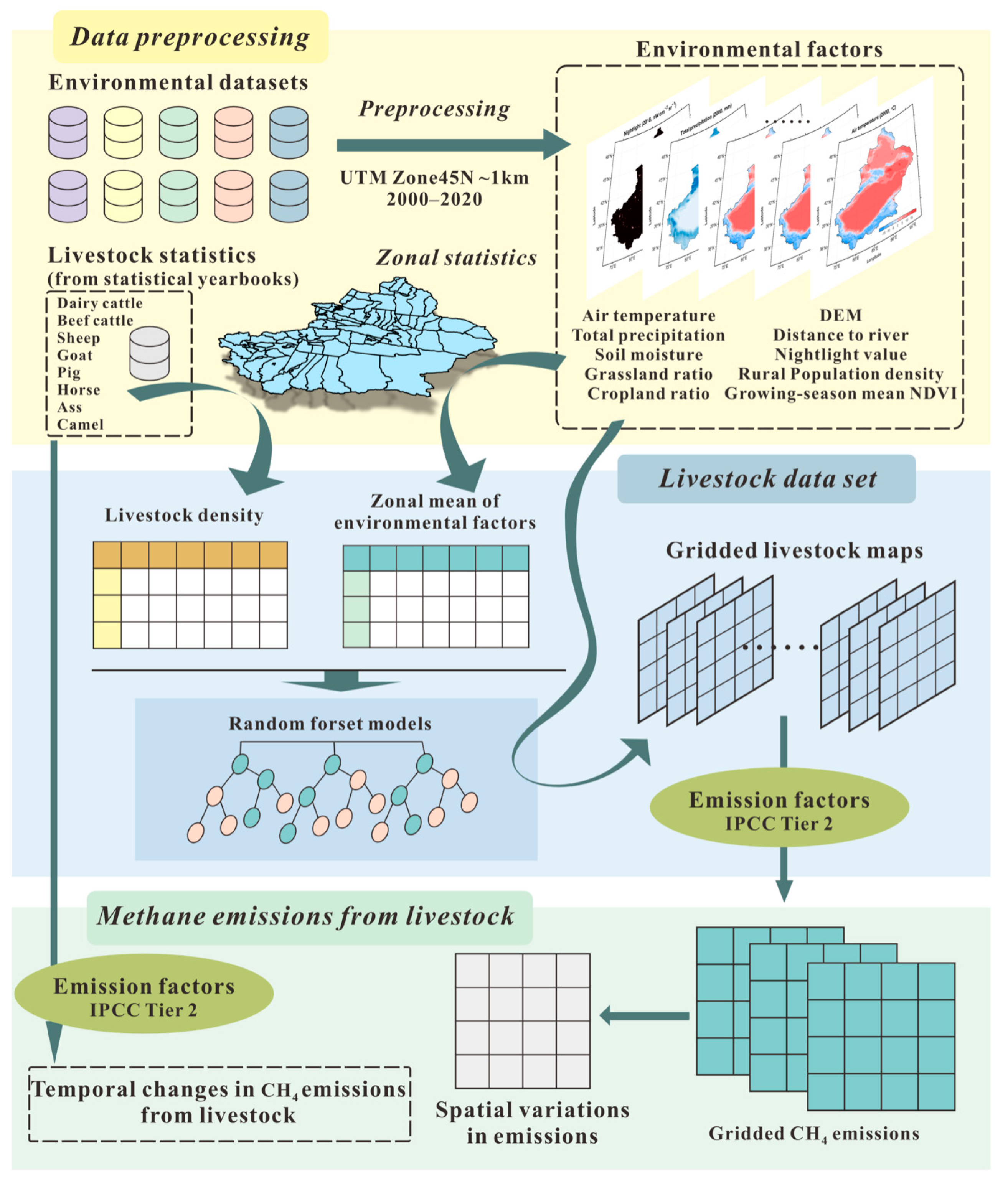
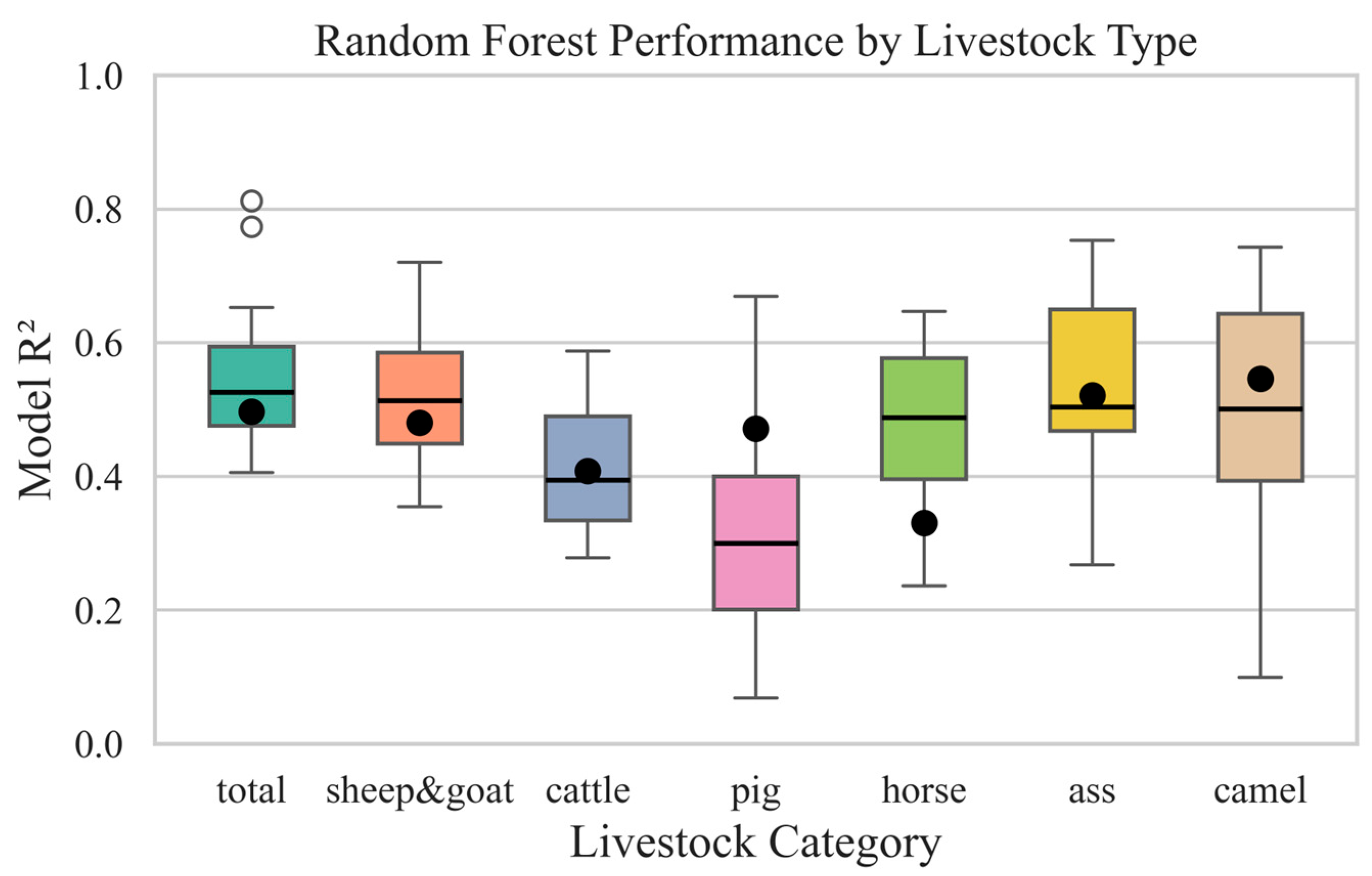

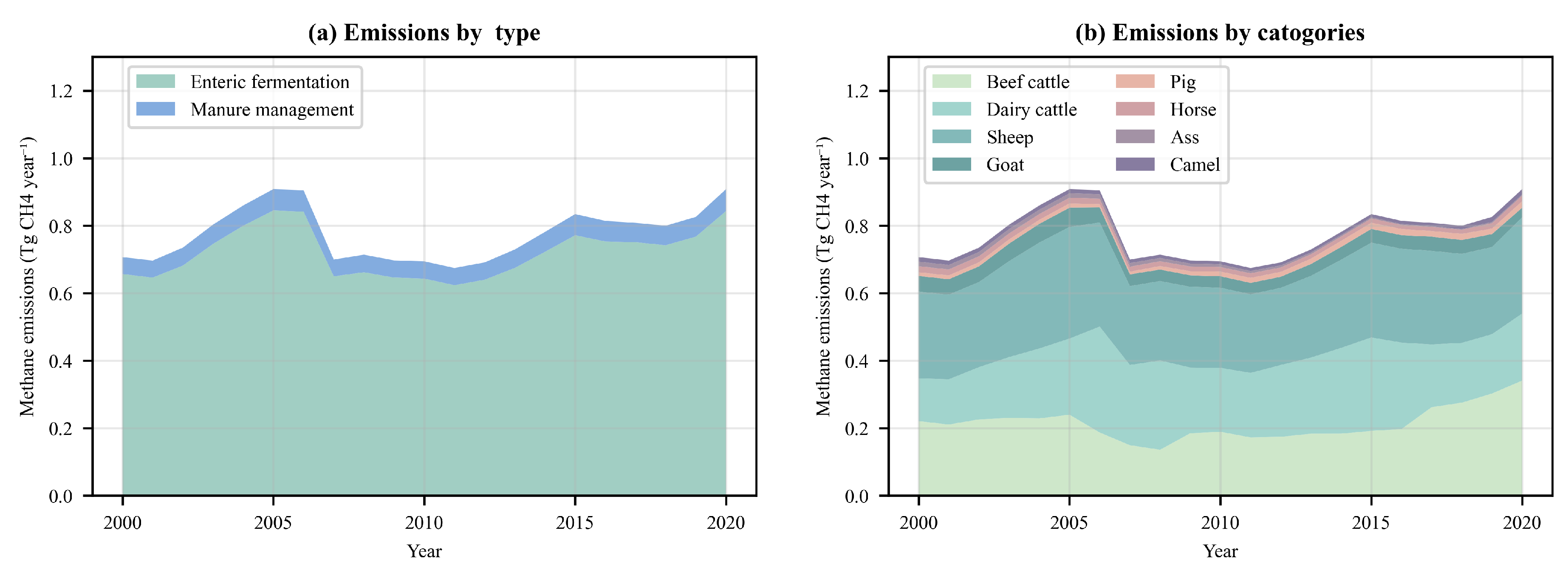
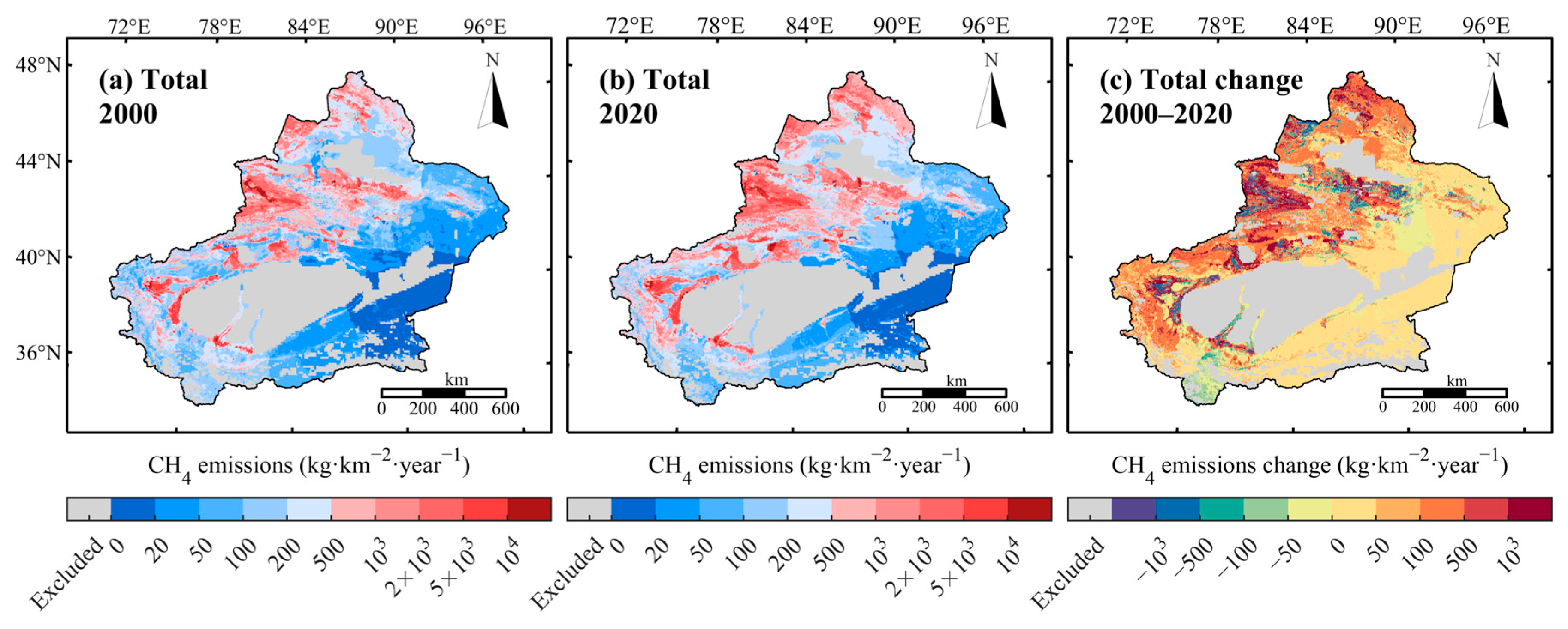
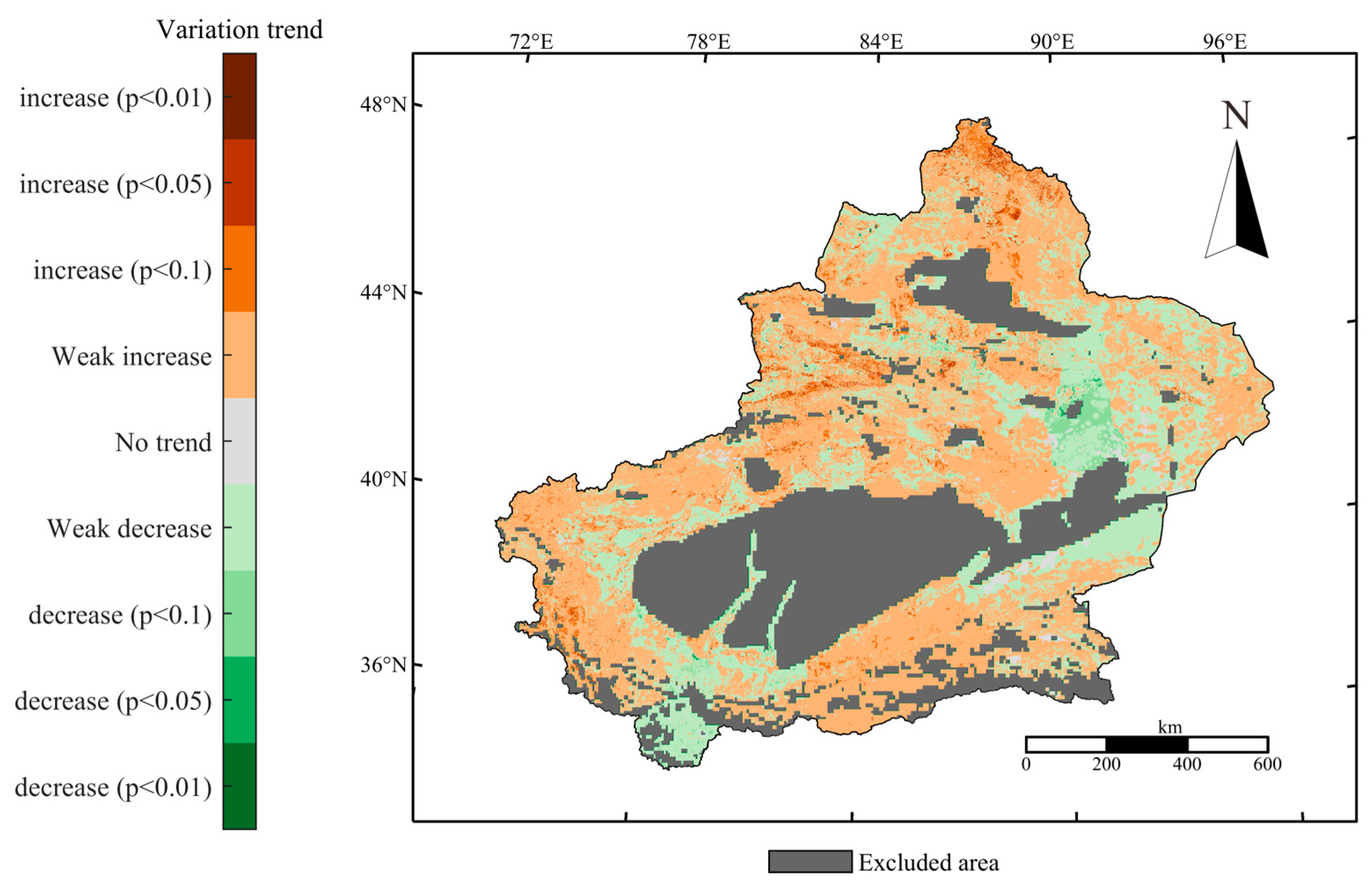
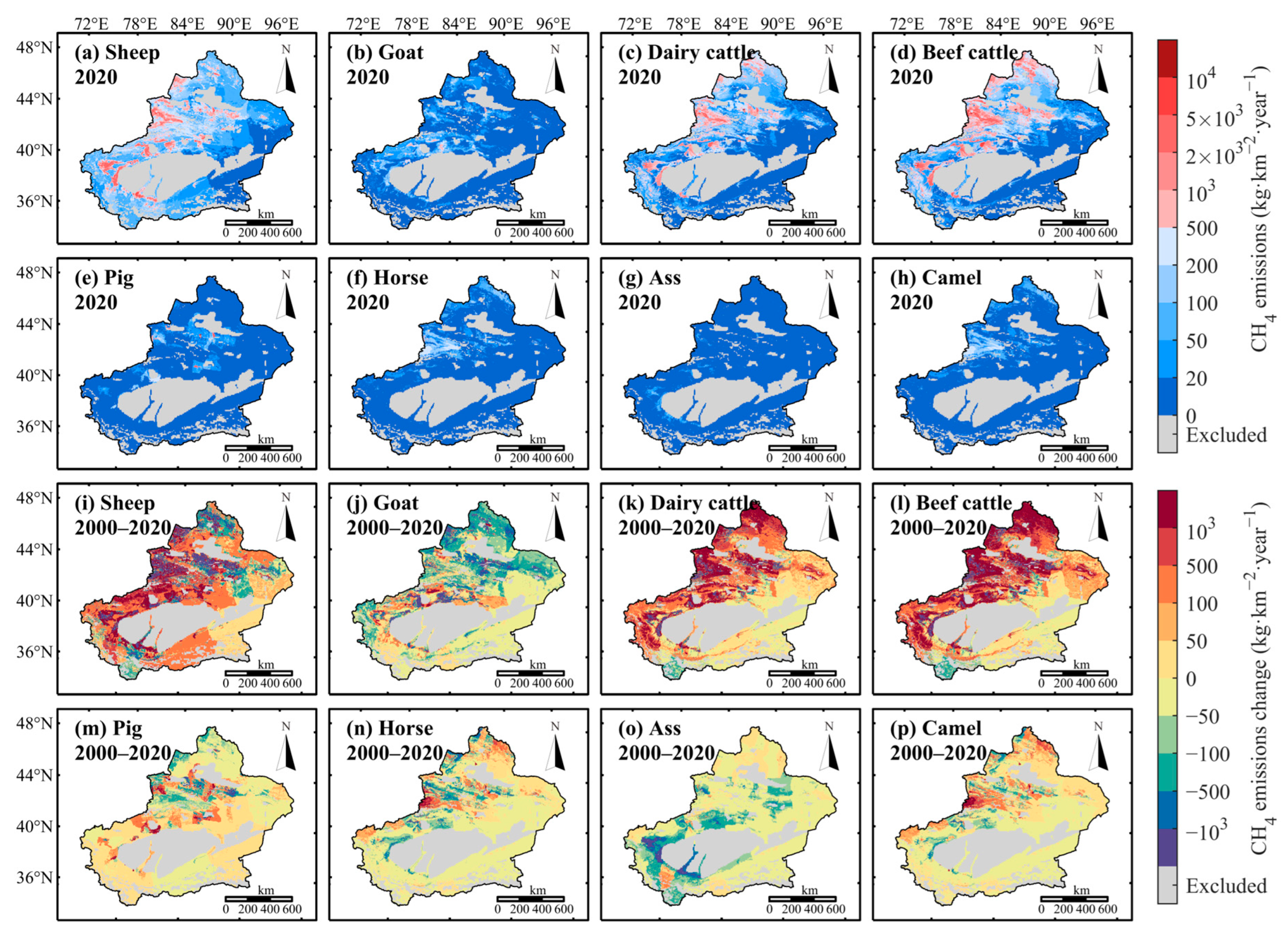
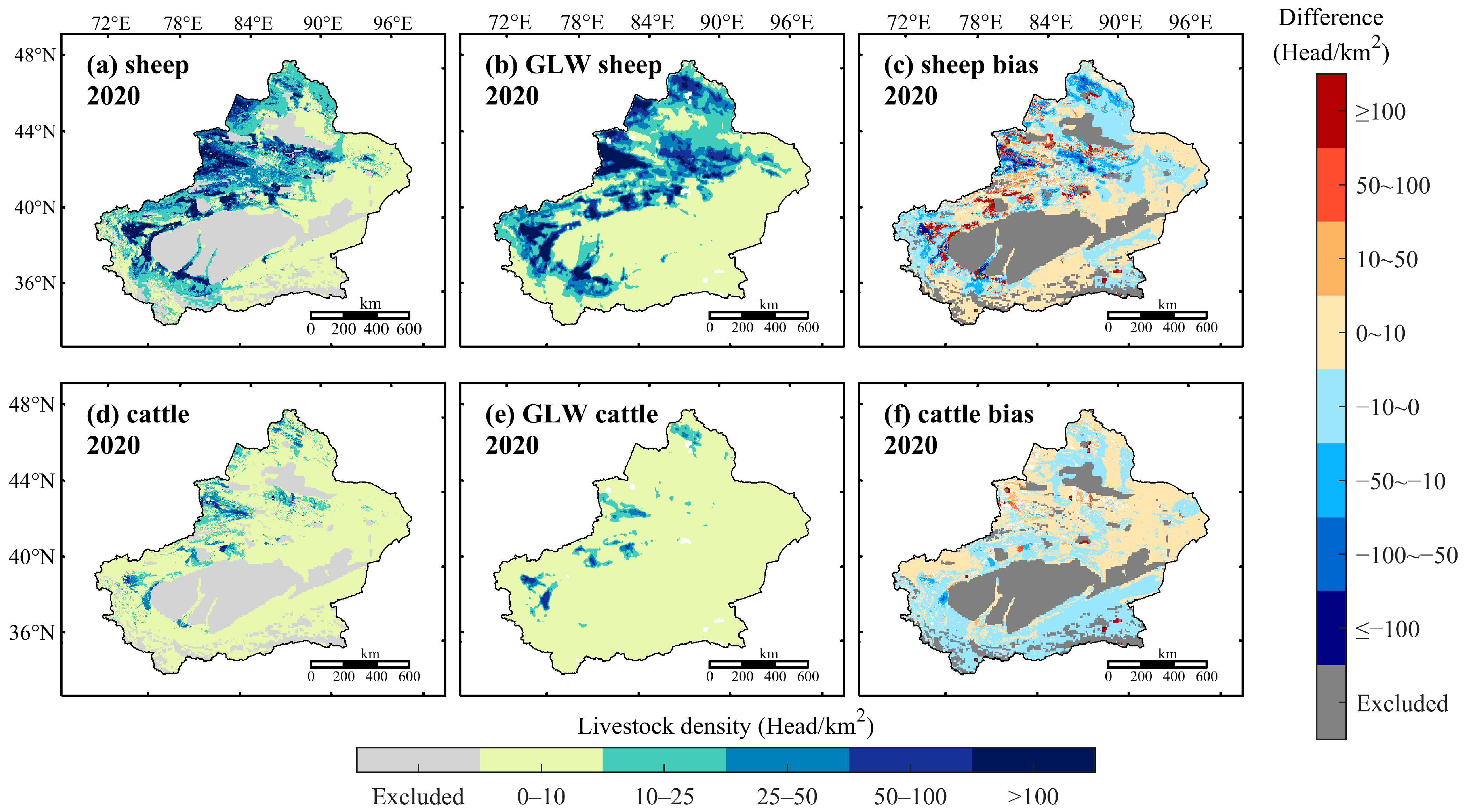
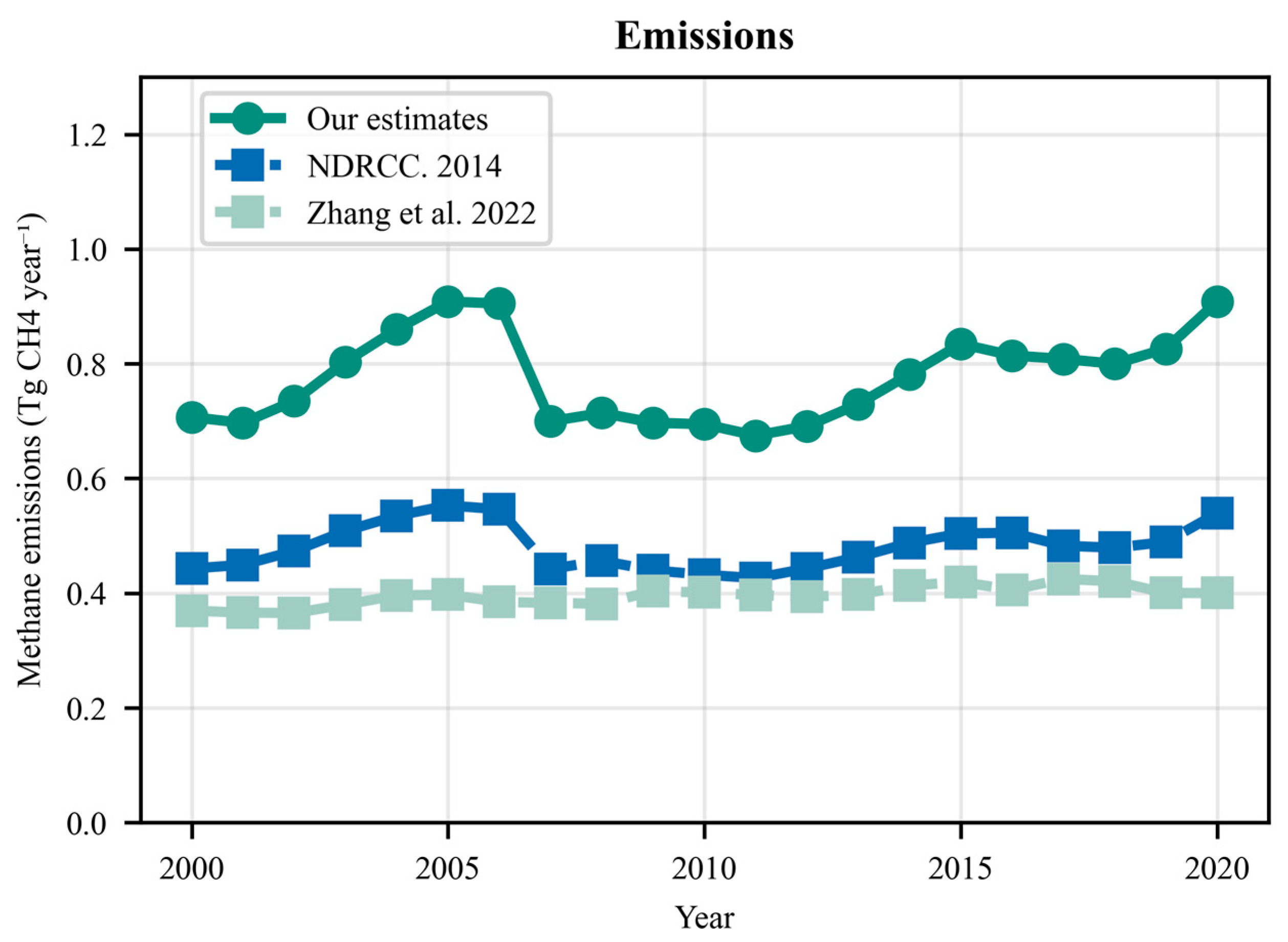
| Dataset | Variables | Spatial Resolution | Temporal Resolution | Period | Ref. |
|---|---|---|---|---|---|
| ERA5-land | Mean air temperature | 0.1° | Monthly | 2000–2020 | [28] |
| Total precipitation | |||||
| ETOPO 2022 | DEM | 15″ | / | 2022 | [29] |
| MOD13A3 v6.1 | Growing-season mean NDVI | 1 km | Monthly | 2000–2020 | [30] |
| GLC_FCS30D | Grassland ratio | 30 m | Yearly | 2000–2020 | [31] |
| Cropland ratio | |||||
| TERRACLIMATE | Soil moisture | ~4 km | Yearly | 2000–2020 | [32] |
| WorldPop | Rural population density | 100 m | / | 2000–2020 | [33] |
| NPP-VIIRS-like Nightlight | Nightlight value | ~500 m | Yearly | 2000–2020 | [34] |
| JRC Monthly Water History | Distance to river | 30 m | Monthly | 2000–2020 | [35] |
| Beef Cattle | Dairy Cattle | Sheep | Goat | Pig | Horse | Ass | Camel | |
|---|---|---|---|---|---|---|---|---|
| 2000 | 0.221 | 0.127 | 0.257 | 0.047 | 0.011 | 0.018 | 0.013 | 0.014 |
| 2005 | 0.240 | 0.226 | 0.331 | 0.057 | 0.013 | 0.017 | 0.013 | 0.013 |
| 2010 | 0.189 | 0.190 | 0.237 | 0.034 | 0.014 | 0.014 | 0.008 | 0.009 |
| 2015 | 0.192 | 0.277 | 0.281 | 0.041 | 0.018 | 0.013 | 0.004 | 0.010 |
| 2020 | 0.341 | 0.199 | 0.285 | 0.029 | 0.019 | 0.017 | 0.003 | 0.016 |
Disclaimer/Publisher’s Note: The statements, opinions and data contained in all publications are solely those of the individual author(s) and contributor(s) and not of MDPI and/or the editor(s). MDPI and/or the editor(s) disclaim responsibility for any injury to people or property resulting from any ideas, methods, instructions or products referred to in the content. |
© 2025 by the authors. Licensee MDPI, Basel, Switzerland. This article is an open access article distributed under the terms and conditions of the Creative Commons Attribution (CC BY) license (https://creativecommons.org/licenses/by/4.0/).
Share and Cite
Xu, Q.; Li, Y.; You, Y.; Zhang, L.; Zhang, H.; Zhang, Z.; Yao, Y.; Huang, Y. Spatial–Temporal Patterns of Methane Emissions from Livestock in Xinjiang During 2000–2020. Sustainability 2025, 17, 9021. https://doi.org/10.3390/su17209021
Xu Q, Li Y, You Y, Zhang L, Zhang H, Zhang Z, Yao Y, Huang Y. Spatial–Temporal Patterns of Methane Emissions from Livestock in Xinjiang During 2000–2020. Sustainability. 2025; 17(20):9021. https://doi.org/10.3390/su17209021
Chicago/Turabian StyleXu, Qixiao, Yumeng Li, Yongfa You, Lei Zhang, Haoyu Zhang, Zeyu Zhang, Yuanzhi Yao, and Ye Huang. 2025. "Spatial–Temporal Patterns of Methane Emissions from Livestock in Xinjiang During 2000–2020" Sustainability 17, no. 20: 9021. https://doi.org/10.3390/su17209021
APA StyleXu, Q., Li, Y., You, Y., Zhang, L., Zhang, H., Zhang, Z., Yao, Y., & Huang, Y. (2025). Spatial–Temporal Patterns of Methane Emissions from Livestock in Xinjiang During 2000–2020. Sustainability, 17(20), 9021. https://doi.org/10.3390/su17209021







